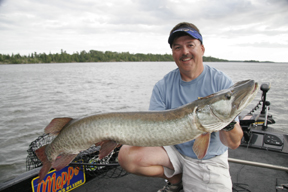By Steve Heiting
I’m not about to name any names, but one of the best musky fishermen I know walked into my office last September and jokingly asked, “What’s a musky?”
It seems my friend had been on a cold streak and was at a loss to explain why. Curiously, I was at the time in the middle of a particularly good stretch of musky action, boating several quality fish each time on the water.

Now, I’m not going to fault my friend. An expert row-troller, each year he boats some of the largest muskies reported in the entire state of Wisconsin. However, when waters begin to cool at the outset of fall, fishing extremely shallow — at depths as shallow as six feet of water and less — is arguably the hottest and most predictable musky pattern to be found.
Think about it. We’ve all heard of the “dog days of August,” when water temperatures soar. While this is a joy for pleasure boaters and a boon to the tourism industry, it leaves musky fishing streaky, at best. During early to mid August you’re going to work for every musky you catch.
But just as the seasons begin to change, so does the fishing action. I emcee the National Championship Musky Open, the largest musky tournament in the world which draws some 1,100 anglers to Eagle River the third weekend in August, and in the days before the tournament each year many of the local guides are concerned about how tough the musky fishing has been. Many of them predict the tournament anglers will struggle. But then comes a huge cold front that knocks water temperatures down into the mid 60s, and suddenly there’s a good bite and lots of muskies get caught and hundreds of tournament anglers go home happy. This illustrates precisely what I’m talking about.
This shallow water bite seems to continue until the lakes turn over, typically when water temperatures fall to the mid to low 50s. And last season’s six-and-in bite was perhaps the best and was certainly the most extended I’ve ever seen. It started in time for the big Eagle River tournament and then the weather seemed to stagnate and water temperatures were steadily in the high 50s to low 60s until early October, which proved to be nearly a two-month window of opportunity. Just what the muskies find in the shallow water — outside of water in their preferred temperature range — is uncertain. Certainly the thickest weeds in the waterbody exist there, and they’ll contain lots of forage. But you don’t need weeds for this bite to occur because I’ve caught hundreds of muskies from rocky structure and shorelines during this time period. A bright sun will warm the shallows but I’ve experienced great fishing in overcast. Wind on a spot helps but is not necessary.
This pattern also exists regardless of musky strain you’re fishing. There’s lots of talk these days comparing the Wisconsin strain of musky with the Minnesota strain, and I state with complete certainty they both bite in shallow water weeds and rocks in the early fall. Do all the muskies in the waterbody head for the shallows? I have no idea and it’s impossible to prove this one way or the other, but certainly those that are shallow are active and those that are in deep water (if they are indeed there) are not. Just remember six-and-in and you should be okay.
Besides the simplicity of this pattern is the ease at which the muskies can be caught. Finesse tactics take a back seat to an in-your- face presentation. Big, high-riding bucktails like a Mepps Musky Marabou all the way up to a Double Cowgirl are terrific provided their blades aren’t bogged down by sloppy weeds. If your in-line bucktails aren’t coming through weed-free enough for your liking, switch to a safety-pin spinnerbait and root ’em out. It’s important that your spinnerbaits have single, upward-riding hooks, for they’ll slide through clingy vegetation or can be easily cleared with a hard rod snap. Topwaters are fine, as are shallow-running crankbaits and giant plastics like the Bull Dawg — big baits mean lots of water movement, and shallow, pre-turnover muskies really seem to home in on this. In thick weeds, lots of water movement can mean the difference in muskies finding your bait or not.
I’ve been targeting this pre-turnover bite for some 15 years, and the action really hasn’t changed. For example, on September 10, 1998, it took nothing more than bucktails and topwaters to produce the best musky fishing day of my life. The water temperature was 66 degrees as a partner and I cast to shallow rock structures that had a moderate southwest wind blowing onto them. Believe it or not (and I have the photos to prove it), by nightfall we had boated 16 muskies measuring from 34 to 45 1/2 inches plus a bonus 40-inch northern pike. When we trailered the boat that night we were slime-covered, sore and tired, but happy. Remarkably, we were the only boat casting for muskies that day on the entire lake.
No single day during last year’s six-and-in bite was anywhere close to that good, but the action was consistent from day to day. Even as September waned and the weeds turned black and scuzzy, casting big bucktails through the slop produced a heady average of two muskies every time out, with the largest stretching the tape to 52 1/2 inches. Is it always this good? Well, no, nothing is guaranteed. But this pattern is the closest I’ve seen in muskie fishing to a sure thing.
Try it, and I think you’ll agree.